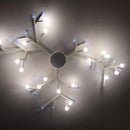Introduction: Modular Tree Lamp - 3D Printed ( or Lasercut )
A fully modular lighting system that can be assembled in many different ways to create unique combinations.
This project is part of my Master's thesis and design research about open-design and distributed design.
I want to get a better understanding and connection to the maker community. Therefore I'm looking forward to see how this project will be received. My hope is that someone, somewhere would like to re-create this and hopefully even customize and re-iterate the design.
Important
If you do decide to make one, please let me know! It would be worth a lot to me to have some documentation and proof that someone else have tried it out. Thanks :)
Attachments
 Modular Tree Lamp - 3D Printed ( or Lasercut )
Modular Tree Lamp - 3D Printed ( or Lasercut ) EndPlug_2of2.stl
EndPlug_2of2.stl EndPlug_1of2.stl
EndPlug_1of2.stl Globe.stl
Globe.stl Globe_Assembly.stl
Globe_Assembly.stl TreeLamp_BASE_v2.stl
TreeLamp_BASE_v2.stl Male_Assembly.stl
Male_Assembly.stl Female_Assembly.stl
Female_Assembly.stl TreeLamp_3way.stl
TreeLamp_3way.stl TreeLamp_1way_extension.stl
TreeLamp_1way_extension.stl TreeLamp_2way.stl
TreeLamp_2way.stl LASER_Y-Way_1.7mm_v2.AI
LASER_Y-Way_1.7mm_v2.AI LASER_Y-Way_0.6mm_v2.AI
LASER_Y-Way_0.6mm_v2.AI LASER_Bayon1_Male_1.7mm_v2.AI
LASER_Bayon1_Male_1.7mm_v2.AI LASER_Bayon1_Female_1.7mm_v2.AI
LASER_Bayon1_Female_1.7mm_v2.AI LASER_Bayon1_1.7mm_v2.AI
LASER_Bayon1_1.7mm_v2.AI LASER_Bayon1_0.6mm_v2.AI
LASER_Bayon1_0.6mm_v2.AI LASER_3-way_0.6mm_v2.AI
LASER_3-way_0.6mm_v2.AI Female_Assembly_Separate_1_of_3.stl
Female_Assembly_Separate_1_of_3.stl Male_Assembly_Separate_3_of_3.stl
Male_Assembly_Separate_3_of_3.stl Male_Assembly_Separate_2_of_3.stl
Male_Assembly_Separate_2_of_3.stl Male_Assembly_Separate_1_of_3.stl
Male_Assembly_Separate_1_of_3.stl Female_Assembly_Separate_3_of_3.stl
Female_Assembly_Separate_3_of_3.stl Female_Assembly_Separate_2_of_3.stl
Female_Assembly_Separate_2_of_3.stl
Supplies
3D Printer (or laser cutter although that version is not completely done)
Soldering Iron
Super Glue
Cable - Make sure it can withstand the amperage. The more lights you've used the thicker the wires must be.
I used a 2x0.75mm² cable complete with EU plug.
Knife
Side cutters (For shortening the + leg on the G4 lamps)
Self-threading Screws 2mm x 8-12mm (Optional)
G4 LED Lamps - https://www.amazon.se/gp/product/B07TLJ1QVC
12V LED Driver - https://www.amazon.se/gp/product/B00WWZFVSC
Power Plugs & Jacks - https://www.amazon.se/gp/product/B01A9SNXIS
Magnets 5x2mm - https://www.amazon.se/gp/product/B0837YQ1WX
Step 1:
This is a simple and modular lighting system. Uses standard 5,5mm DC plugs for the power and the parts connect to each other with bayonet mounts. The lamp can be used as a table or floorlamp or mounted to the ceiling.
Step 2:
For each section you’ll need to assemble a male plug to put in one end and 1-3 females, depending on if it’s a one, two or three-way section. Note that the female assembly need a male plug and the male assembly needs a female jack.
Step 3:
The assembly of both the male and female connection is similar. The connector fits within two pieces and is secured by a third that could be either glued or screwed, or both. This ensures that the connector can’t be pushed out of the assembly.
It’s preferable to superglue everything to be sure nothing falls off later.
Step 4:
The wiring is as simple as it gets. The cables need to be 18cm for any of the sections, separate cables for each lead is easier to fit inside the three-way section than a two-lead cable like the one used in the picture. Make sure you don’t mix polarity, using a multimeter is a great way to make sure everything is hooked up correctly before closing the parts and plugging them in.
Step 5:
The lights themselves need some modification of the DC jack in order to shorten it down. It might not be strictly necessary but is needed to get the LED lamp in the middle of the globe.
Cut the jack as shown, cut through the plastic coating until you reach bare metal and pull off the plastic until you can solder the LED pins on the proper lead. +12V goes in the middle pin and the outer acts as ground ( -12V ).
Step 6:
The solder will keep the lamp secured to the jack. Glue the connector to the plastic part and then glue the whole assembly inside the globe.
Step 7:
The base will hold three female connectors and the 12V transformer for the LEDs. Again make sure polarity is correct everywhere before hooking it up to the mains supply.
It’s also a good idea to add some kind of strain relief for the cable so you can’t accidentally pull it out of the LED driver. I’ll probably add this into the model but I was in a rush and as an afterthought I used some discarded support interface structures and some CA glue. If you want the lamp to be mounted in the ceiling you’ll need to print the ceiling base or the middle part for the base that can fit a hook.
Step 8:
There's also some end plugs that can be attached to the spots where you don't want a light source.
Step 9:
Repeat the process as many times as you want so you have enough pieces to play around with them to try different combinations.
Step 10:
I’ve also begun to make a version of the lamp that can be made with a laser cutter and 2mm cardboard instead of using a 3d printer. So far I’ve only made the different 1, 2 and 3-way sections and still need to make a base and a foldable solution for the lights themselves. Could be something like a dodecahedron or similar. I’m not sure when or even if I’ll finish that part of the project, but if I notice that there’s interest for it I’ll make sure to finish it.
It’s more work to assemble this version than using the 3d printed parts but I like the more handcrafted expression as well that it uses no plastic.





























